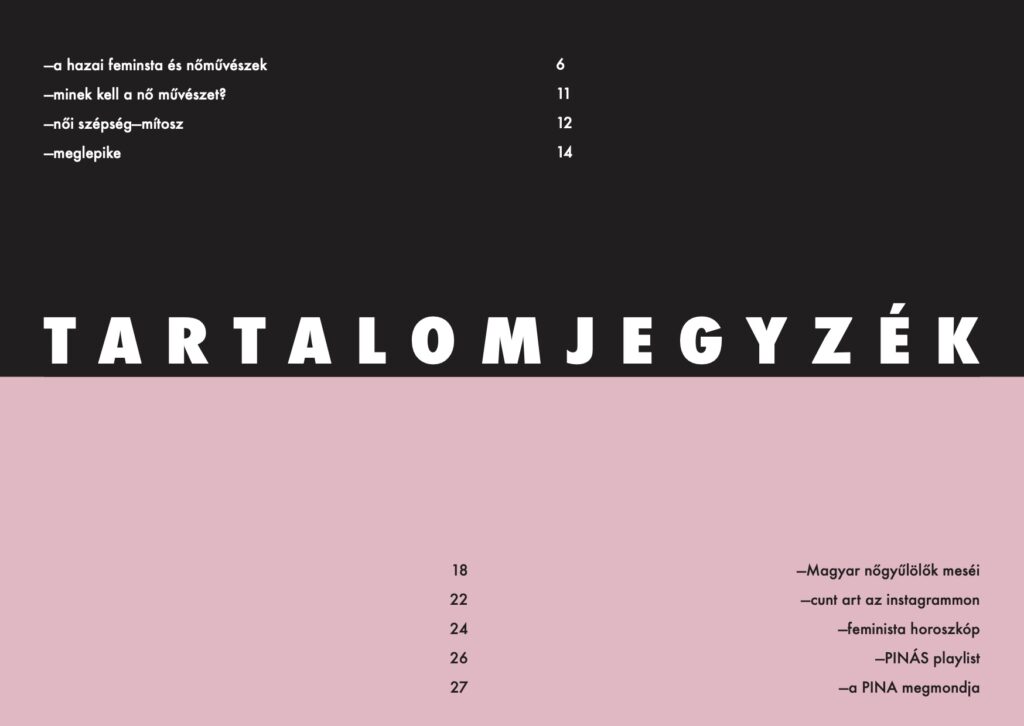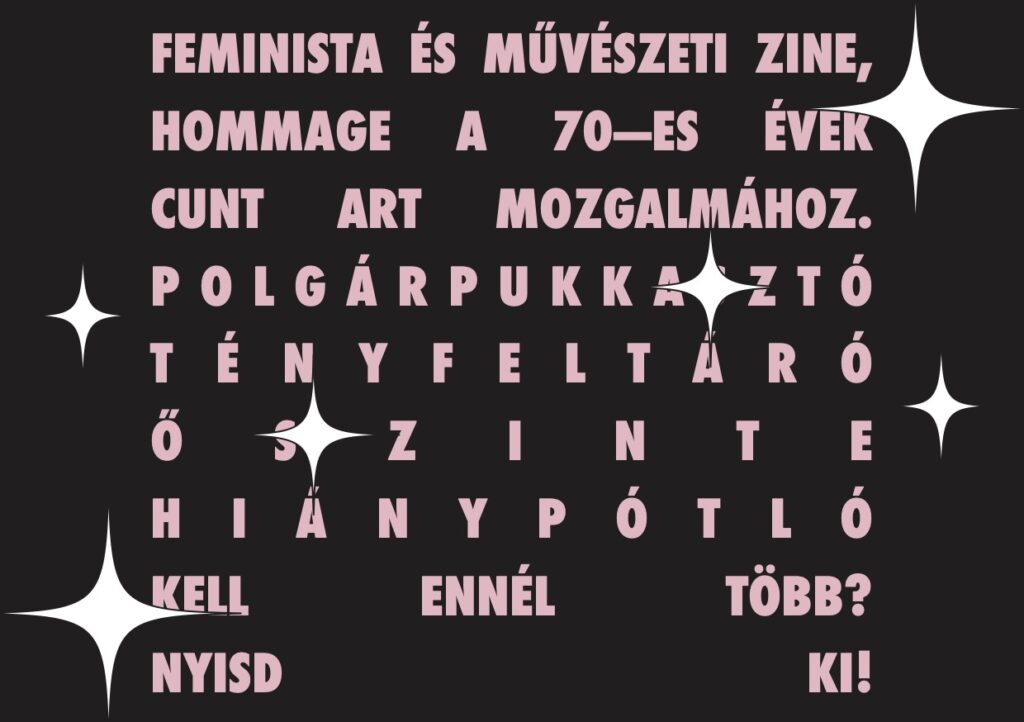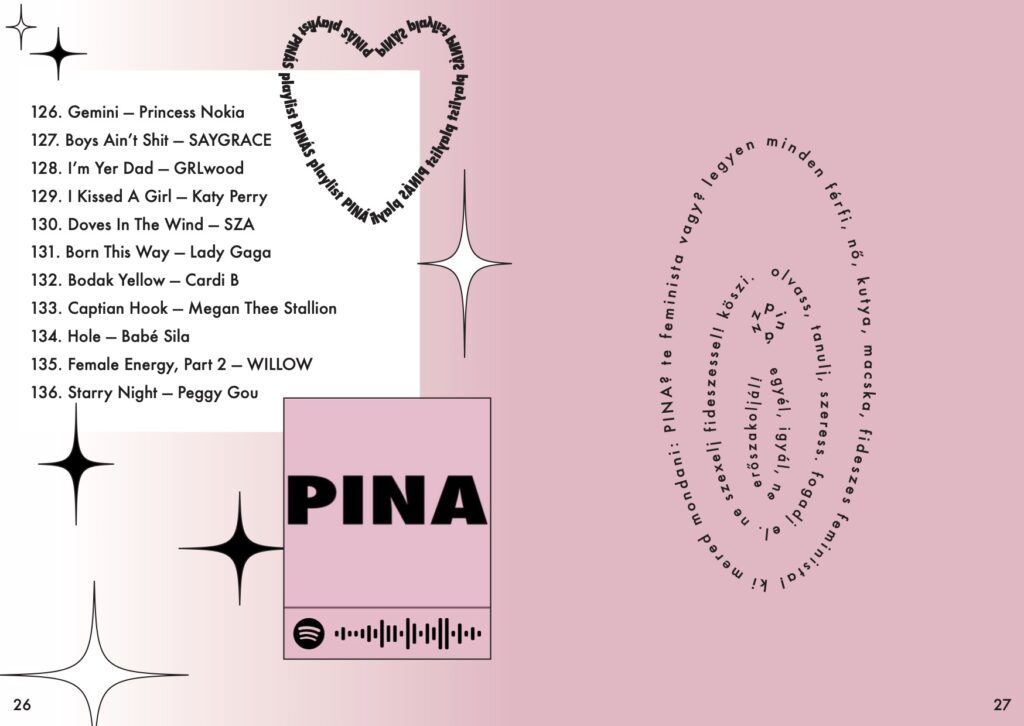PINA Zine (or Cunt Zine in English) is an independent, self-published Hungarian zine created and edited by Miss Pina. It’s dedicated to feminism and feminist art, inspired by the Cunt Art movement and its pioneers in the 1970s. The first printed edition was released in 2019 and is available to purchase on a number of platforms. (more info here)
We are also delighted to share with you some sneak peeks of the second PINA issue, so just keep reading!
Q: Hello Miss Pina, lovely to finally meet you (although virtually). I have had the chance to have a glimpse at the previous issue of PINA Zine in real-life as well, which I very much enjoyed. Can you talk me through the founding of Pinazine – where did the idea come from, was it motivated by any sort of personal experience, and how did you end up choosing the Zine format?
Hi, I’m also delighted to meet you! I’m happy to hear you’ve enjoyed reading the zine.
The idea of PINA Zine have originated from my application to MOME (Moholy-Nagy University of Art and Design), this is when I have familiarised myself with feminist art, especially with the work of Judy Chicago. I found this topic incredibly interesting – something which I have not heard a lot about before, at least not in a Hungarian context – and I felt that I need to share my knowledge with everyone (even if no one cares).
While I’ve always liked the zine format, it was when my friend (who is a graphic designer) had to create a personal zine for a school project that the idea of making my own zine crystallised. I envied the freedom and excitement that the zine medium carries. So, that’s when I decided that my own little personal project will also take this format.
Q: You often refer to the 70s as the main inspiration for your work, can you tell us a bit more about the significance of this period? Is this reference more ‘nostalgic’ or refers to actualities within PINA Zine?
When I was planning the first issue of the Zine, I have decided that it will strictly be about feminist art. Then I realised that this is impossible – I cannot leave out the background/context of its emergence. The deeper I dwell into history, the more I come to the conclusion that the progressive movement/shift of the 70s both in art and in feminism is still relevant today. Of course, a lot has been achieved, but I believe that there is still so much to be done. Through the Zine, I try to contrast and find the parallels between the nostalgia of the 70s with the realities of 2020.
Q: “Pina” (cunt in Hungarian) still feels like a bit of a taboo word in Hungary – at least in some circles or environments. What is the underlying motivation behind the name – is it to normalise the word or to be provocative? Do you have any personal stories related to this question?
The usage of the word pina is partly a homage to the Cunt Art movement, partly to provoke outrage and attention, but most importantly, my goal is to reclaim the pejorative connotation of the word and instead give it a liberating meaning. Not to mention that the word fasz (dick) is used on a daily basis, we hear it much more frequently. It would be great if the word pina would not remind us of some degrading expression such as hülye pina (stupid cunt).
Actually, for me, it’s quite shocking that many women cannot say out loud, or even write down the word. I’ve received plenty of such comments from women, ‘what’s with all the cunt talk?” ‘what’s all this about?’ ‘what makes this feminist?’ ‘why do you need to label your work with this title, and why do you need to write it down so many times?’ I think these comments shed light on the underlying issue.

PINA Zine #2 Sneak peek: Table of contents
If we, women, cannot even say out loud the name of one of our greatest parts of our bodies, do we just leave it up to men, to use it as they wish, even in a pejorative sense? Thanks, I’d rather choose to say it.
Q: You’ve already created Pina Zine, Pina Insta, Pina Playlist and Pina Etsy. To what extent do you imagine the future of your platform as a ‘Pina brand’ with Pina merch? Or would you rather maintain the DIY, anti-capitalist ethos of the punk era?
Originally, I’ve thought of the PinaZine Instagram as a complimentary online platform alongside the zine, knowing that the printed format, which only comes out in 20-30 copies, will not reach a broader audience. The playlist is a little fragment out of the zine that the readers can take away with themselves. It’s such a good feeling to have something to listen to while getting ready for a party with your girlfriends, or all alone in the car, or literally anytime, anywhere.
I basically do not profit from making the Zine and it’s not necessarily my goal either, I’d just like to share my art. It feels really cool to see my prints in Nos (Hungarian design shop), or Pinazine’s and Nemnőügy’s (Not a “Women’s Issue”) women’s day special edition in Leanzer Newcraft. If someone wants to support me, they can do so by purchasing these products. The Pina Etsy was created for making the zine accessible beyond Budapest as well by ordering it online.
As a university student, who does Pina Zine in her free time, I don’t think that I’m contributing to capitalism through my work. However, I would like to make Pina merch in the future; not to become an influencer and to give out promo codes or anything like that – I create everything together with my boyfriend in a tiny bedroom. So, Pina is really still my personal little project. Getting a nice message and getting good feedback on my work is still what matters to me the most. If I could only help one girl by creating Pina, it’s been already worth it.
Q: Do you view Pina Zine as a form of activism? If yes, what social issues exactly would you like to bring people’s attention to, within or beyond feminism?
I definitely view it as activism. The anonymity, the Miss Pina alter ego also serves the goal of not being able to connect the zine and the movement to one single person, I don’t want this to be about me. I want everyone to be able to relate to Miss Pina. Primarily I write about feminist art and its importance, but I also have my opinion of Hungarian men and I’m not afraid to write it down. My objective with Pina isn’t to lecture or cancel anyone, unlike several Facebook groups. It’s a great feeling to see that it’s more and more of us with a similar value-system who are fighting for similar goals with their platforms, such as Vénusz Projekt, Nemnőügy, Eszti Tóth or Ciklusmesék. Our common objective is to empower women, make them share their opinions and feel understood via insta posts, for instance.
Q: Perhaps this is a bit of a heavy question, but in your opinion, what is the role of feminism today, and where do you see PINA Zine within that? How are the issues you discuss in your zine through feminist art come alive in your social circles or generation? And what about the intergenerational aspect of it – for instance, could you discuss the content you share with your mum?
Huh, yes, not an easy question indeed. In Hungary, I still feel that feminism is not a trendy thing, it isn’t widespread at all. Ok, perhaps in Budapest. But I believe that Hungary has a long way to go when it comes to feminist education. This is what I try to contribute to with PINA, mostly touching the younger generations, people in their 20s and 30s. I would like to make the content I share widely accessible and enjoyable, and to communicate it without any sort of over-intellectualised, high-minded context.
In my point of view, feminism is becoming increasingly ‘cool’ in my generation. Although I feel that this has been partly achieved by fast fashion brands’ obsession with the #girlpower slogan, of course, feminism is much more than that.
That’s why I believe that it’s important to be feminists not just on a superficial level but to truly stand up for each other, educate each other, do not bitch about each other behind our backs (something that I do not consider #girlpower at all).
Fortunately, I can freely and openly discuss these issues with my family, it is always great to listen to different generations’ and genders’ perspectives on particular topics. Anyway, they have been extremely supportive when it comes to my project.

PINA Zine #2 issue
Q: What do you think of the expression “feminazi” (suggesting an aggressive and overly prescriptive form of feminism)? Have you ever been labelled by this expression?
Of course, I’ve been called a feminazi before. Although if I’m honest, I don’t even know who or what counts as a femináci today. If I am called a femináci because I stand up for my values, for saying pina (cunt) out loud, for speaking about issues rooted in the patriarchal nature of our societies – issues that also affect men – then I am a proud femináci.
In contrast, a guy who constantly talks about how women belong to the kitchen, can’t drive, how they are only good for so and so, is considered a ‘man with traditional values’. If a woman is confident, loves herself, and perhaps says that she’s the best in the world, then we regard her as femináci, because she must believe that she’s better than men. Am I the only one sensing a contradictory dichotomy here?
Q: Who inspires you, whether it’s other artists or publications, in terms of aesthetic and content?
My inspiration changes constantly. Surely I have my main idols and big names that I get inspired by, but often my experiences from everyday life shape my content as well. I love Pinterest, it helps me a lot with getting inspiration for my graphics, but I also try to work with digital art, for which the illustrations and work of @reesabobesa motivate me a lot. I like everything that’s childish, honest and naive, and I also really like the little trashy aesthetic of the 2000s. I try to combine these with some rebelliousness and the irony of Miss Pina for the zine and my Instagram page.

PINA Playlist
Q: What do you think a progressive Fasz Zine (=Dick Zine) would look like?
My boyfriend and I joke around a lot that he will launch Fasz Zine, though we don’t have a specific look or idea in mind. The idea of a progressive Fasz Zine reminds me of the penis-shaped graffitis on concrete, I think it would be an exciting pairing to use the alt-punk aesthetic with serious topics relating to male identities such as toxic masculinity, mysticisms around penis size and the hierarchy surrounding it that men create between each other. But I might be thinking too much into it… or a Fasz Zine might already exist, who knows?
Q. Both you and the magazine’s identity have a close connection to contemporary art and art history – if you could be the curator of an imaginary Pina Exhibition (potentially even including the art of deceased artists), who would you exhibit and what would be the main narrative (within the Pina theme of course)?
I am really hoping that one day in Hungary a Pina Exhibition could become a reality and that people would be interested in visiting. I find the Vagina Museum in London really cool, and I love how there the value of art in such a similar topic is not questioned at all. I really hope we’ll see this in Hungary as well in the future.
In this dream exhibition, I would definitely exhibit works from Judy Chicago, Hannah Wilke, Niki de Saint Phalle, Mihályi Barbara (@_barbart_), Éva Szombat and Kata Oltai. Though I would also strive to give an opportunity to younger artists like me to introduce themselves and their art to the audience. The narrative would be really simple: Women, who stood up for themselves and their rights, women, who showcase the real world, and women, who do not conform to the expectations of our patriarchal society.
Q: Can we expect to see any new, exciting projects from PinaZine? What are your plans?
The past month was somewhat difficult for me personally, and so there was a long hiatus on the PINA platform, but I’ve been having a lot of ideas. I’m currently running an open-call project, with a lot of submissions, and I’m also experimenting with new mediums regarding PINA art. I’m trying to find some new inspiration as I would rather not get stuck in an Instagram-influencer loophole. The PINA Zine #2 is out soon, which is very close to my heart, as it has a brand new design, and I’m exploring several different topics in 28 pages. I loved working on it! I am also looking into different directions before getting started on issue #3. Soon it’s the first birthday of PINA, and the 20th birthday of Miss Pina, which I’d love to celebrate in a special way, with an exciting project.
Interview by Sonja Teszler.
Translated by Zsofi Borsi and Bori Tóth.

